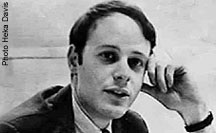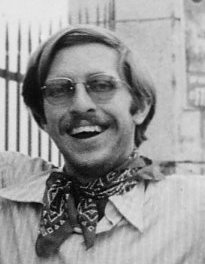Welcome to DU!
The truly grassroots left-of-center political community where regular people, not algorithms, drive the discussions and set the standards.
Join the community:
Create a free account
Support DU (and get rid of ads!):
Become a Star Member
Latest Breaking News
General Discussion
The DU Lounge
All Forums
Issue Forums
Culture Forums
Alliance Forums
Region Forums
Support Forums
Help & Search
General Discussion
Related: Editorials & Other Articles, Issue Forums, Alliance Forums, Region ForumsThe Case of Charles Horman and Frank Teruggi


The recent torture report reminded me of the case of Charles Horman and Frank Teruggi, two left-wing American citizens who were tortured and executed after the Chilean coup on September 11, 1973, along with thousands of other Chilean Leftists.
From the link below: Both Horman and Teruggi were seized separately at their homes in Santiago by Chilean soldiers and subsequently executed while in detention. Their murders, and the seeming indifference of U.S. officials, were immortalized in the Oscar-award winning movie "Missing" which focused on the search by Horman's wife and father for him in the weeks following the U.S.-supported coup.
According to the first declassified document below, "circumstantial evidence" exists suggesting that "U.S. intelligence may have played an unfortunate part in Horman's death."
Unfortunate, indeed.
http://www2.gwu.edu/~nsarchiv/NSAEBB/NSAEBB366/
Read the Documents:
Document 1
Department of State, SECRET Memorandum, "Charles Horman Case," August 25, 1976
This memo by three state department officers implies that the U.S. government could have prevented the murder of Charles Horman. The memo, written after a review of the files on the case, explains that there is "circumstantial evidence" to suggest "U.S. intelligence may have played an unfortunate part in Horman's death. At best, it was limited to providing or confirming information that helped motivate his murder by the GOC. At worst, U.S. intelligence was aware the GOC saw Horman in a rather serious light and U.S. officials did nothing to discourage the logical outcome of GOC paranoia." When this document was initially declassified pursuant to a FOIA lawsuit filed by the Horman family, this critical passage was blacked out. The document was released without redaction in 1999. It was not cited in Judge Zepeda's indictment, but appears to reflect the judicial argument he is pursuing.
Document 2
Department of State, SECRET, "Charles Horman Case: Gleanings,"
This detailed chronology, based on a review of files available to the State Department, contains key information on what the U.S. knew and did in the case of Charles Horman. It also evaluates the possible role of the U.S. in the murder. The document cites the admissions of a Chilean intelligence agent, Rafael Gonzalez, who told U.S. reporters the story of Horman being interrogated in General Augusto Lutz's office and then killed because "he knew too much." Gonzalez claimed there was an American in the room when the interrogation took place, but decades later he would recant that story. In January 2004, he was indicted by Judge Zepeda in the Horman case as an "accessory to murder" for his role in the interrogation, death and secret burial of Charles Horman.
Document 3
United States Embassy, Unclassified Notice, "Missing United States Citizen," October 9, 1973
This document cited in the indictment, states that the U.S. government has received a note from the Chilean Foreign Office dated October 3, 1973, recording that Charles Horman was detained at the National Stadium on September 20 for a curfew violation but had been released on September 21 for "lack of merit." The document includes a photograph of Horman, his date of birth, address in Chile, and fingerprint classification. Horman was actually detained at his home on September 17, 1973.
Document 4
Department of State, Memorandum (classification excised), "Film by Charles Horman," April 12, 1974
In this memo to Assistant Secretary Harry Shlaudeman, State Department officer George Lister describes the film work of Charles Horman. A film that he apparently worked on before the coup was completed after the coup by friends titled "Chile: With Poems and Guns." (The document leaves the impression that Charles "made" the film, but clearly he did not work on it following the coup.) The film describes Chilean history, and the achievements of the Allende government, along with alleged atrocities of the coup and U.S. involvement. Lister goes so far as to imply that Horman's film making in Chile could have been what "led to his death."
Document 5
Chilean Armed Forces, Memorandum, "Antecedentes sobre Fallecimiento de 2 ciudadanos norteamericanos," Octobeer 30, 1973
Chief of Chilean Military Intelligence Service General Augusto Lutz reports on the death of Charles Horman and Frank Teruggi. He asserts that Horman and Teruggi were political extremists attempting to discredit Chilean junta. While he acknowledges that they were both detained by the Chilean military, he maintains that they were later released and that the Chilean military was not involved in their deaths. The document is the only information known to have been provided by the Chilean military to the U.S. embassy after the disappearance of Horman and Teruggi.
Document 6
U.S. Military Group Chile, Memorandum (classification unknown), "Case of Charles Horman," January 14, 1975
Ray Davis forwards a list of documents on the interactions of the U.S. Military Group in Chile with Charles Horman to be provided to the General Accounting Office. The documents raise the issue of the role of embassy officials in the disappearance and death of Horman, and make "certain allegations and statements about members of the Navy Mission, in Valparaiso; comments about a ride given by COMUSMILGP, Captain Davis."
Document 7
Department of State, CONFIDENTIAL Memorandum, "Horman Case," April 20, 1987
This memorandum of conversation reports on an informant who has appeared at the Embassy to give testimony on the death of Charles Horman. According to this informant, Horman was seized by Chilean intelligence units and taken to the Escuela Militar for questioning. He was then transferred to the National Stadium, where they determined he was an extremist. He was forced to change clothes, shot three times, and his body was dumped on the street to appear he had died in a confrontation. The informant said that "the person at the stadium who made the decision on who was to die was Pedro Espinoza, of later DINA fame." The document is the first to tie Pedro Espinoza to the Horman case. He was involved in military intelligence and detainees at the time of the coup. However, the commander of the National Stadium at the time was another military officer named Jorge Espinosa Ulloa.
Document 8
United States Embassy Santiago, CONFIDENTIAL cable, '[Excised] Reports on GOC Involvement in Death of Charles Horman, Asks Embassy for Asylum and Aid,' April 28, 1987
In a report on the informant's information, the Embassy cables Washington with his account of Horman's death. Horman was picked up in a routine sweep, the informant suggests, and was found in possession of "extremist" materials. He was then taken the National Stadium where he was interrogated and later executed on the orders of Pedro Espinoza. Embassy officials note that his story "corresponds with what we know about the case and the [Chilean government] attempt to cover up their involvement," suggesting that the informant is probably telling the truth. In later cables, the Embassy begins to question the credibility of the informant who is never identified.
Document 9
FBI, SECRET Memorandum, [Frank Teruggi's Contact with Anti-War Activist], October 25, 1972
This FBI report cites information provided by "another U.S. government agency" on Frank Teruggi's contacts with an anti-war activist who resides in West Germany. The report also contains his address in Santiago. The document was generated by surveillance of a U.S. military intelligence unit in Munich on an American anti-war dissident who was in contact with Teruggi. The FBI subsequently decides to open a file on Teruggi. This series of FBI documents were cited by Judge Zepeda in his indictment which infers-but offers no proof-- that intelligence from them was shared with Chilean military intelligence in the days following the coup.
Document 10
FBI, SECRET Memorandum, "Frank Teruggi," October 25, 1972
This FBI memorandum requests investigation of Frank Teruggi and the Chicago Area Group for the Liberation of Americas of which he was a member nearly a year prior to his death following the Chilean coup.
Document 11
FBI, SECRET Memorandum, "[Excised] SM- Subversive," November 28, 1972
This FBI document again requests investigation on Teruggi based on his contact with a political activist in West Germany. The document mentions that Teruggi is living in Chile editing a newsletter "FIN" of Chilean information for the American left, and that he is closely affiliated with the Chicago Area Group for the Liberation of Americas.
Document 12
FBI, Memorandum (classification unknown), "Frank Teruggi," December 14, 1972
This FBI memorandum demonstrates ongoing efforts to gather information on Frank Teruggi in the year proceeding the Chilean coup. Here, the FBI reports on his attendance at a conference of returned Peace Corps volunteers and his membership in political organizations supporting socialism and national liberation movements in Latin America.
InfoView thread info, including edit history
TrashPut this thread in your Trash Can (My DU » Trash Can)
BookmarkAdd this thread to your Bookmarks (My DU » Bookmarks)
0 replies, 1386 views
ShareGet links to this post and/or share on social media
AlertAlert this post for a rule violation
PowersThere are no powers you can use on this post
EditCannot edit other people's posts
ReplyReply to this post
EditCannot edit other people's posts
Rec (2)
ReplyReply to this post